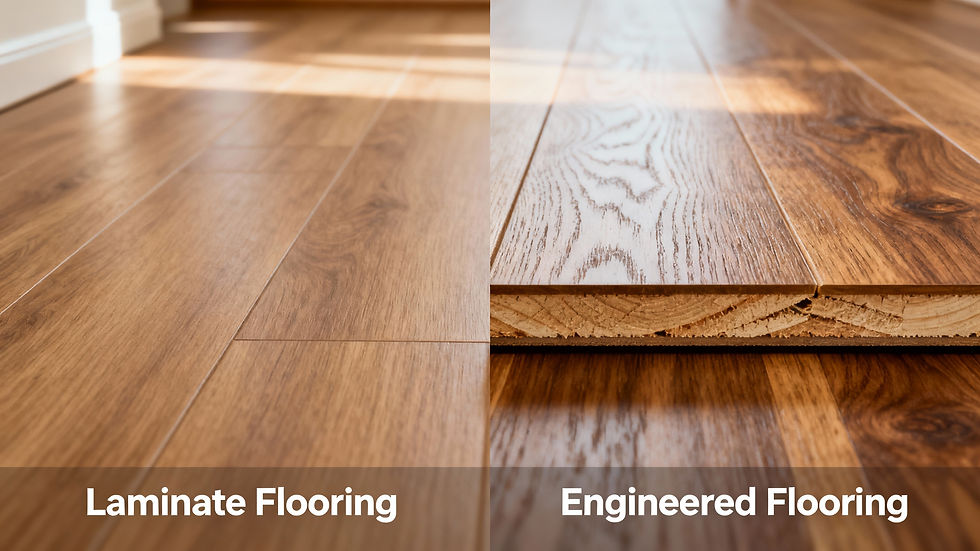Laminate vs Engineered Flooring: Which Is the Better Choice for Your Home?
- contactdefloors
- Nov 12
- 3 min read

When choosing wooden flooring, two names often come up — laminate flooring and engineered wood flooring. Both look stylish, but their performance, feel, and longevity differ significantly. At DeFloors, we help homeowners understand these distinctions clearly so they can choose flooring that matches lifestyle, budget, and local climate conditions.
What Is Laminate Flooring?
Laminate flooring is a synthetic, multi-layered material designed to imitate natural wood. It includes:
A backing layer for stability
A dense HDF (High-Density Fiberboard) core
A decorative photographic layer that replicates wood grains
A protective melamine or aluminum-oxide wear layer
While it offers the warm look of wood, laminate doesn’t contain real timber on the surface. It’s valued for its durability, affordability, and quick installation.
What Is Engineered Wood Flooring?
Engineered flooring is made using a thin real-wood veneer (lamella) on top of a plywood or HDF core. The layers are arranged in a cross-ply construction, which increases dimensional stability and reduces seasonal expansion or contraction. This makes it more moisture-resistant than solid hardwood while retaining the authentic texture and grain of real wood.
Appearance and Texture
If you value authentic wood aesthetics, engineered flooring stands out because its top layer is real hardwood. Each plank displays natural variations, textures, and grain depth that synthetic laminates cannot replicate completely.
Laminate, however, uses high-definition printing and embossing to achieve a consistent wood-look surface. While it looks realistic from a distance, pattern repetition can sometimes reveal that it’s not real wood.
Durability and Longevity
Laminate floors are known for exceptional scratch and stain resistance, especially when rated AC3 or higher. This makes them suitable for high-traffic homes, offices, or rental properties. However, laminate cannot be sanded or refinished once the top layer wears out.
Engineered wood, while softer, can be refinished depending on veneer thickness, giving it a much longer service life. A well-maintained engineered floor can last for decades, maintaining its appearance and resale value.
Water Resistance and Climate Suitability
Neither laminate nor engineered flooring is fully waterproof. Prolonged exposure to water can cause swelling or warping. However, engineered wood’s cross-layered core handles humidity better, making it more stable in tropical or monsoon-affected regions like many parts of India.
Laminated Wood Flooring, especially standard HDF types, is more sensitive to moisture. Water-resistant versions are available, but even they require immediate spill clean-up and proper underlay protection.
For Indian climates, it’s essential to prepare the subfloor with moisture barriers and maintain indoor humidity. With correct installation, both options can perform well.
Installation and Maintenance
Laminate floors usually come with a click-lock floating installation system, allowing fast, clean, and even DIY-friendly setup. Engineered wood can be installed as floating, glued, or nailed-down planks, depending on the manufacturer’s specifications.
Maintenance differs slightly:
Laminate: Regular sweeping or dry vacuuming, light damp mopping only, and immediate cleaning of spills.
Engineered wood: Use specialized wood cleaners and avoid wet mopping or steam cleaning to preserve the veneer layer.
Sustainability and Environmental Considerations
Engineered wood uses real timber veneers and can be FSC-certified, supporting sustainable forest management. Laminate flooring, made from fiberboard and resins, varies in eco-impact depending on brand quality and VOC emissions. Always check certification details such as FSC, PEFC, or low-VOC compliance when selecting materials.
Which One Should You Choose?
Here’s a practical way to decide:
Criteria | Laminate Flooring | Engineered Wood Flooring |
Surface Material | Synthetic, photographic layer | Real hardwood veneer |
Durability | Highly scratch-resistant | Moderate; can be refinished |
Moisture Resistance | Moderate (depends on HDF core) | Better stability in humidity |
Installation | Easy floating system | Glue or nail down options |
Maintenance | Very low; no refinishing | Requires periodic care |
Authenticity | Wood-look imitation | Real wood appearance |
Longevity | 10–20 years typical | 20–30+ years with care |
Final Thoughts from DeFloors
If you want natural warmth, long-term value, and the ability to refinish, choose engineered wood flooring. It’s ideal for homeowners planning to stay long-term or add premium value to interiors.
If you prefer affordability, durability, and easy installation, laminate flooring remains a reliable, modern choice—especially for high-traffic areas or rental spaces.
At DeFloors, we provide both laminate and engineered flooring options, helping you compare specifications, finishes, and maintenance needs before installation. Each project deserves the right foundation, and our team ensures your floors remain beautiful, stable, and lasting for years to come.
Comments